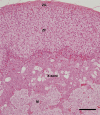Practical approaches for evaluating adrenal toxicity in nonclinical safety assessment
- PMID: 26441474
- PMCID: PMC4588206
- DOI: 10.1293/tox.2015-0025
Practical approaches for evaluating adrenal toxicity in nonclinical safety assessment
Erratum in
-
Errata (Printer's correction).J Toxicol Pathol. 2016 Jan;29(1):74. Epub 2016 Feb 17. J Toxicol Pathol. 2016. PMID: 26989306 Free PMC article.
Abstract
The adrenal gland has characteristic morphological and biochemical features that render it particularly susceptible to the actions of xenobiotics. As is the case with other endocrine organs, the adrenal gland is under the control of upstream organs (hypothalamic-pituitary system) in vivo, often making it difficult to elucidate the mode of toxicity of a test article. It is very important, especially for pharmaceuticals, to determine whether a test article-related change is caused by a direct effect or other associated factors. In addition, antemortem data, including clinical signs, body weight, food consumption and clinical pathology, and postmortem data, including gross pathology, organ weight and histopathologic examination of the adrenal glands and other related organs, should be carefully monitored and evaluated. During evaluation, the following should also be taken into account: (1) species, sex and age of animals used, (2) metabolic activation by a cytochrome P450 enzyme(s) and (3) physicochemical properties and the metabolic pathway of the test article. In this review, we describe the following crucial points for toxicologic pathologists to consider when evaluating adrenal toxicity: functional anatomy, blood supply, hormone production in each compartment, steroid biosynthesis, potential medulla-cortex interaction, and species and gender differences in anatomical features and other features of the adrenal gland which could affect vulnerability to toxic effects. Finally practical approaches for evaluating adrenal toxicity in nonclinical safety studies are discussed.
Keywords: adrenal cortex; adrenal medulla; nonclinical toxicity; species differences; steroidogenesis.
Figures






References
-
- Hammer GD, Parker KL, and Schimmer BP. Minireview: transcriptional regulation of adrenocortical development. Endocrinology. 146: 1018–1024. 2005. - PubMed
-
- Vinson GP, Whitehouse BJ, and Hinson JP. The Adrenal Cortex. Prentice Hall, New Jersey. 1992.
-
- Kierszenbaum AL. Endocrine system. In: Histology and Cell Biology: An Introduction to Pathology, 2nd ed. Elsevier Ltd., Philadelphia. 537–567. 2007.
-
- Hornsby PJ. The regulation of adrenocortical function by control of growth and structure. In: Adrenal Cortex. DC Anderson and JSD Winter (eds). Butterworth, London. 1–31. 1985.
-
- Hornsby PJ. Physiological and pathological effects of steroids on the function of the adrenal cortex. J Steroid Biochem. 27: 1161–1171. 1987. - PubMed
Publication types
LinkOut - more resources
Full Text Sources
Other Literature Sources
Research Materials
